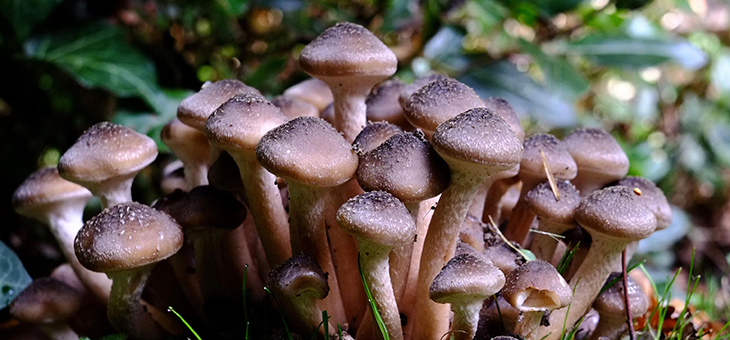These days we can buy mushrooms in all shapes and sizes, foraging for them in fields and forests or even having a go at cultivating them ourselves.
But there’s more to fungi than just eating them, says biologist and mushroom expert Merlin Sheldrake.
There are fungi that can alter the weather, some that can survive in deep space, while others can thrive amidst nuclear radiation, he writes in his acclaimed book, Entangled Life. Nearly all life on earth relies on fungi to exist and survive, he has discovered.
“For as long as I can remember I’ve been fascinated by fungi and the transformations they provoke. As a teenager I dealt with my bafflement by finding ways to involve myself with fungi. I picked mushrooms and grew mushrooms in my bedroom. Whether in forests, labs or kitchens, fungi have changed my understanding of how life happens.”
How easy is it to grow mushrooms in your garden?
“Many species will grow in gardens without any assistance,” he says. “Some might appear on rotting logs or fence posts, or as brackets on trees. Others might sprout from lawns.
Read: Could mushrooms be the health booster you’re missing?
“There are a number of species that can be cultivated for those who want to play a more active role. A number of delicious mushroom species can be bought as dowel plugs and drilled into logs, including shiitake, lion’s mane and oyster mushrooms. Some, like king stropharia, can be established in wood chip beds.”
Why are they so important to the environment?
“Mushrooms are only the fruiting bodies of fungi: for the most part fungi live their lives as branching, fusing networks of tubular cells known as mycelium. Mycelial networks weave themselves through plant roots and shoots, animal bodies, sulfurous sediments on the ocean floor, grasslands, and forests.
“Fungi increase the volume of water that the soil can absorb, reducing the quantity of nutrients leached out of the soil by rainfall by as much as 50 per cent.
“Of the carbon that is found in soils – which, remarkably, amounts to twice the amount of carbon found in plants and the atmosphere combined – a substantial proportion is bound up in tough organic compounds produced by fungal mycelium. The carbon that floods into the soil through fungal channels supports intricate food webs.”
Where can you buy mushrooms to grow?
“Grow kits (available from specialists and online retailers including Amazon) are possibly the easiest way to begin. A block of fungal mycelium arrives in a bag, which you then open and spray with water. Within a few days, mushrooms start to sprout.
“You can also buy wooden dowel plugs inoculated with fungal mycelium which you then drill into logs, or bags of inoculated wood chips that you use to make a fungus bed in your garden.
“Then again, nearly all plants depend on symbiotic fungi living in their roots and shoots. What we call ‘plants’ are in fact fungi that have evolved to farm algae, and algae that have evolved to farm fungi.
“If you care about plants, you care about the fungi without which plant life would be impossible. Any plant we buy from a garden centre will come with its own community of fungi which we cultivate without giving it further thought.”
Read: Study shows the power of mushrooms
The magic of mushrooms
“Fungi are metabolic wizards and can explore, scavenge and salvage ingeniously. Few environments are too extreme,” he points out.
“A species isolated from mining waste is one of the most radiation-resistant organisms ever discovered. The blasted nuclear reactor at Chernobyl is home to a large population of such fungi. A number of these radio-tolerant species even grow towards radioactive ‘hot’ particles. They appear to be able to harness radiation as a source of energy, as plants use the energy in sunlight.
“Some species discharge spores explosively, which accelerate 10,000 times faster than a space shuttle directly after launch, reaching speeds of up to 100km per hour – some of the quickest movements achieved by any living organism.”
Read: Do the Dirty Dozen and Clean Fifteen lists apply to Australia?
Fungi facts
“Fungi produce around 50 mega tonnes of spores each year – equivalent to the weight of 500,000 blue whales – making them the largest source of living particles in the air. Spores are found in clouds and influence the weather by triggering the formation of the water droplets that form rain, and ice crystals that form snow, sleet and hail.
“A number of fungal species produce bioluminescence, which causes their mushrooms and mycelium to glow in the dark. Coal miners in 19th century England reported that bioluminescent fungi growing on wooden pit props were bright enough to ‘see their hands by’.”
Entangled Life: How Fungi Make Our Worlds, Change Our Minds And Shape Our Futures by Merlin Sheldrake, published by Bodley Head, available now.
Are you a mushroom fan? Would you ever try growing your own? Why not share your favourite way to eat mushrooms in the comments section below?
– With PA
If you enjoy our content, don’t keep it to yourself. Share our free eNews with your friends and encourage them to sign up.

